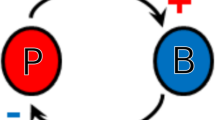Abstract
Mathematical and computational models for the propagation of activity in excitatorily coupled neurons are simulated and analyzed. The basic measurable quantity—velocity—is found for a wide class of models. Numerical bifurcation techniques, asymptotic analysis, and numerical simulations are used to show that there are distinct scaling laws for the velocity as a function of a variety of parameters. In particular, the obvious linear relationships between speed and spatial spread or synaptic decay rate are shown. More surprisingly, it is shown that the velocity scales as a power law with synaptic coupling strength and that the exponent is dependent only on the rising phase of the synapse.
Similar content being viewed by others
References
Amari S-I (1977) Dynamics of pattern formation in lateral-inhibition type neural fields. Biol. Cybernetics 27:77–87.
Burns BD (1950) Some properties of the cat's isolated cerebral cortex J. Physiol. Lond. 111:50–68.
Chagnac-Amitai Y, Connors BW (1989) Horizontal spread of synchronized activity in neocortex and its control by GABA-mediated inhibition. J. Neurophysiol. 61:747–758.
Chen Z, Ermentrout B, McLeod JB (1997) Traveling fronts for a class of non-local convolution differential equations. Applicable Analysis 64:235–253.
Chen Z, Ermentrout B, Wang X-J (1998) Wave propagation mediated by GABAA synapse and rebound excitation in an inhibitory network: A reduced model approach. J. Comput. Neuro. 5:53–69.
Chervin RD, Pierce PA, Connors BW (1988) Periodicity and directionality in the propagation of epileptiform discharges across neocortex. J. Neurophysiol. 60:1695–1713.
Destexhe A, Mainen ZF, Sejnowski TJ (1994) Synthesis of models for excitable membranes, synaptic transmission, and neuromodulation using a common kinetic formalism. J. Comput. Neurosci. 1:195–230.
Destexhe A, Bal T, McCormick DA, Sejnowski TJ (1996) Ionic mechanisms underlying synchronized oscillations and propagating waves in a model of ferret thalamic slices. J. Neurophysiol. 76:2049–2070.
Doedel E (1986) AUTO: Software for continuation and bifurcation problems in ordinary differential equations. CalTech Technical Document.
Ermentrout GB (1994) Reduction of conductance based models with slow synapses to neural nets. Neural Comput. 6:679–695.
Ermentrout GB, McLeod JB (1993) Existence and uniqueness of traveling waves for a neural network. Proc. Roy. Soc. Edinburgh 123A:461–478.
Ermentrout GB, Chen X, Chen Z (1997) Transition fronts and localized structures in bistable reaction-diffusion equations. Physica D 108:147–167.
Gerstner W, van Hemmen JL, Cowan JD (1996) What matters in neuronal locking? Neural Comput. 8:1653–1676.
Golomb D, Wang XJ, Rinzel J (1996) Propagation of spindle waves in a thalamic slice model. J. Neurophysiol. 75:750–769.
Golomb D, Amitai Y (1997) Propagating neuronal discharges in neocortical slices: Computational and experimental study. J. Neurophysiol. 78:1199–1211.
Idiart MAP, Abbott LF (1993) Propagation of excitation in neural network models. Network 4:285–294.
Kim U, Bal T, McCormick DA (1995) Spindle waves are propagating synchronized oscillations in the ferret LGN in vitro. J. Neurophysiol. 74:1301–1323.
Kleinfeld D, Delaney KR, Fee MS, Flores JA, Tank DW, Gelperin AK (1994) Dynamics of propagating waves in the olfactory network of a terrestrial mollusk: An electrical and optical study. J. Neurophysiol. 72:1402–1419.
Koch C, Segev I (1989) Methods in Neuronal Modeling. MIT Press, Cambridge, MA, ch. 5.
Murray JD (1989) Mathematical Biology, Springer, New York.
Petsche H, Prohaska O, Rappelsberger P, Vollmer R, Kaiser A (1974) Cortical seizure patterns in the multidimensional view: The information content of equipotential maps. Epilepsia 15:439–463.
Pinto D (1997) Computational experimental, and analytical explorations of neuronal circuits in the cerebral cortex, Ph.D. Thesis, University of Pittsburgh, Department of Mathematics.
Rinzel J, Terman D, Wang XJ, Ermentrout GB (1998) Propagating activity patterns in large scale inhibitory neuronal networks, Science 279:1351–1354.
Traub RD, Jefferys JGR, Miles R (1993) Analysis of propagation of disinhibition-induced after-discharges along the guinea-pig hippocampal slice in vitro. J. Physiol. Lond. 472:267–287.
Wilson HR, Cowan JD (1973) A mathematical theory for the functional dynamics of cortical and thalamic tissue. Kybernetic 13:55–80.
Wang XJ, Rinzel J (1992), Alternating and synchronous rhythms in reciprocally inhibitory model neurons. Neural Comput. 4:84–97.
Author information
Authors and Affiliations
Rights and permissions
About this article
Cite this article
Ermentrout, B. The Analysis of Synaptically Generated Traveling Waves. J Comput Neurosci 5, 191–208 (1998). https://doi.org/10.1023/A:1008822117809
Issue Date:
DOI: https://doi.org/10.1023/A:1008822117809




